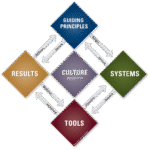
In the innovation ecosystem, we often wonder where the next great entrepreneurs will emerge from. The traditional answer points to business schools, but what if the next disruptor is a biologist, an engineer, or a historian? The reality is that entrepreneurial competencies—such as creativity, problem-solving, and resilience—are crucial in every professional field. The major bottleneck is not a lack of student talent, but a lack of educators prepared to cultivate it outside of traditional silos.
A recent study by Fufen Jin and Gunhild Marie Roald from the Norwegian University of Science and Technology (NTNU), published in the scientific journal Cogent Education, tackles this challenge head-on. Their research evaluates a teacher professional development (TPD) program specifically designed to train educators from diverse disciplines, from engineering to the humanities, in teaching entrepreneurship. The results provide a roadmap for any institution aspiring to become a truly entrepreneurial university.
Key Findings from the Study
- Instructors in non-business fields often lack the confidence and tools to teach entrepreneurship. Specific, practical training significantly increases their self-assurance and competence.
- The primary goal of “embedded entrepreneurship” is not for every student to launch a company, but for them to develop an entrepreneurial mindset applicable to any professional or social challenge.
- Active, hands-on methods where instructors “learn by doing” are fundamental. The evaluated program was based on constructivist and experiential approaches that the educators later replicated in their own classrooms.
- Professors who received the training not only changed their teaching methods but also observed greater engagement and better learning outcomes in their students, who became more creative and participatory.
The Challenge: Taking Entrepreneurship Beyond the Business School
For years, policymakers and organizations like the OECD and the European Commission have pushed for the integration of entrepreneurship education (EE) at all educational levels. In practice, however, this has encountered a significant barrier: professors in disciplines like engineering, social sciences, or health often feel unprepared and fail to see the relevance of teaching entrepreneurship.
The study identifies two approaches to solve this: bringing in external experts as guest speakers, or the more sustainable path of training the existing faculty in each discipline to integrate entrepreneurship organically into their courses. This latter method, known as Embedded Entrepreneurship Education (EEE), is the most promising, as it contextualizes entrepreneurial skills within the student’s field of study, making them more relevant and accessible.
The Solution: A Training Program That Transforms Mindsets
The NTNU team designed an intensive two-day program called “Entrepreneurship Education for Better Learning.” This elective course was aimed at faculty from across the university and focused on three pillars:
- The WHY: To inspire and motivate educators by showing the relevance of entrepreneurship in their respective fields and how it can better prepare their students for 21st-century challenges.
- The WHAT: To provide a practical and easy-to-apply framework called I-CARE (Interact, Challenge, Act, Reflect, and Embrace uncertainty), designed to foster entrepreneurial competencies through active teaching methods.
- The HOW: To train instructors in concrete pedagogical tools, such as pitching, demonstrating how an essential entrepreneurial skill can be used to improve communication and persuasion in any discipline.
From Skepticism to Action
To measure the program’s impact, the researchers used a mixed-methods approach, combining pre- and post-course surveys with follow-up interviews months later. The evaluation was based on the robust Kirkpatrick model, which measures reaction, learning, behavior, and results.
Immediate impact: A measurable rise in confidence and knowledge
The quantitative data left no room for doubt. Before the training, the faculty’s confidence (mean of 3.50 out of 5) and competence (mean of 2.94 out of 5) in teaching entrepreneurship were low. After the course, confidence soared to 4.81 and competence rose to 3.78—statistically significant differences. Participants also rated the course as highly relevant and engaging, feeling it provided them with applicable knowledge for their daily work.
Long-term impact: Real changes in the classroom
This is where the research becomes truly powerful. Follow-up interviews revealed that the training was not an isolated event but a catalyst for lasting change.
- Behavioral change: Professors began to experiment with more interactive, student-centered teaching methods. An engineering professor, for instance, organized a pitching competition in his class for students to present projects to a real environmental fund, achieving surprising levels of participation and creativity.
- Disciplinary “Identification”: A fascinating finding was the process of “identification,” where educators connected entrepreneurial concepts to their own field. A neuromedicine instructor realized that making a pitch was similar to clearly and convincingly explaining a treatment plan to a patient. An engineer recognized that his discipline’s “problem-solving mindset” was already, in essence, a form of entrepreneurial thinking. This personal connection was key to adoption.
- Student outcomes: The change in the instructors’ pedagogy had a direct effect on learning. Educators reported that their students were more engaged, learned from one another, and generated more innovative ideas. This not only improved the student experience but also revitalized the professors’ own motivation.
Implications for Innovation and the Future of Education
This study demonstrates that investing in teacher training is a high-impact strategy for fostering a culture of innovation and entrepreneurship in higher education. It is not enough to decree that entrepreneurship must be taught in all degree programs; it is essential to empower educators with the tools, confidence, and mindset to do so effectively.
For innovation leaders in business and academia, the message is clear: if we want a new generation of proactive, creative professionals capable of solving complex problems, we must start with their instructors. Programs like the one evaluated in this study offer a proven and effective model for achieving this, demonstrating that with the right support, any professor from any discipline can become a catalyst for the entrepreneurial spirit.
Contact
Fufen Jin
Department of Industrial Economics and Technology Management, The Norwegian University of Science and Technology (NTNU)
Trondheim, Norway
Email: fufen.jin@ntnu.no
Reference (open access)
Jin, F., & Roald, G. M. (2025). Training university educators to foster embedded entrepreneurship education: an evaluation. Cogent Education, 12(1). https://doi.org/10.1080/2331186X.2025.2564255
Editor and founder of “Innovar o Morir” (‘Innovate or Die’). Milthon holds a Master’s degree in Science and Innovation Management from the Polytechnic University of Valencia, with postgraduate diplomas in Business Innovation (UPV) and Market-Oriented Innovation Management (UPCH-Universitat Leipzig). He has practical experience in innovation management, having led the Fisheries Innovation Unit of the National Program for Innovation in Fisheries and Aquaculture (PNIPA) and worked as a consultant on open innovation diagnostics and technology watch. He firmly believes in the power of innovation and creativity as drivers of change and development.





